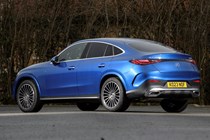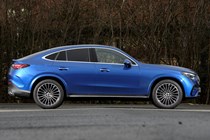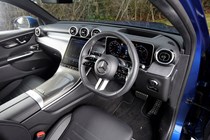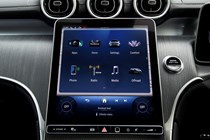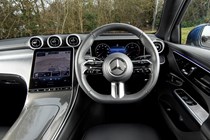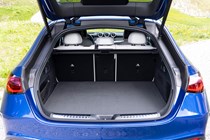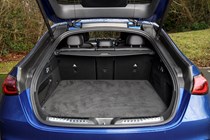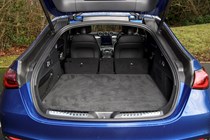
Mercedes-Benz GLC Coupe review
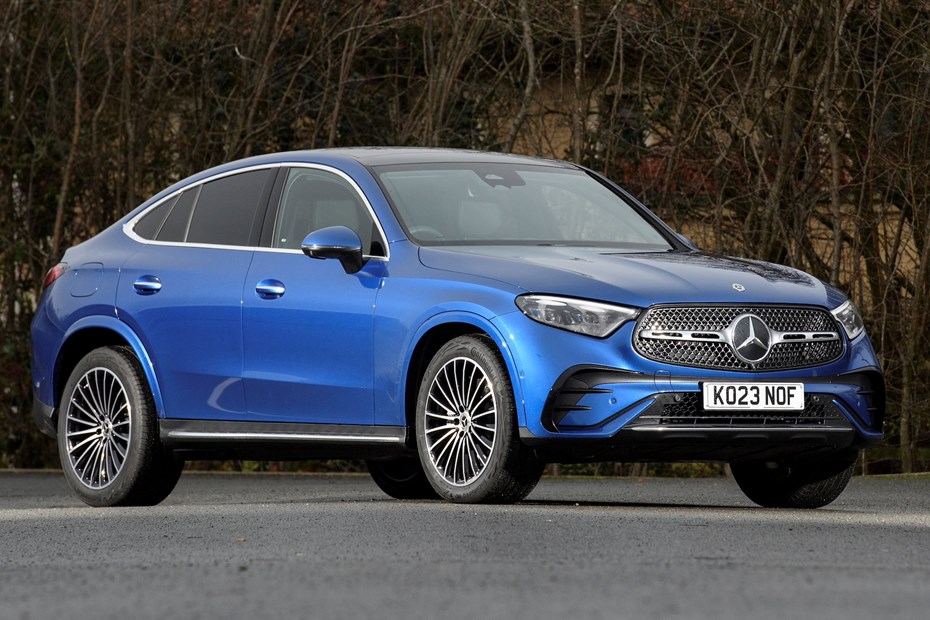
At a glance
| Price new | £59,110 - £79,685 |
|---|---|
| Used prices | £44,185 - £65,744 |
| Road tax cost | £590 - £600 |
| Insurance group | 41 - 49 |
Get an insurance quote with

|
|
| Fuel economy | 35.3 - 53.3 mpg |
| Miles per pound | 5.2 - 6.8 |
| View full specs for a specific version | |
Available fuel types
Petrol
Diesel
Alternative fuel
Pros & cons
- 300d model is quick
- High-quality interior
- Standard four-wheel drive
- More expensive than a standard GLC
- Smaller boot and less headroom
- No PHEV option in the UK
Overview
The second-generation Mercedes GLC Coupe is a classic automotive niche-splitting exercise – but the niche it occupies is steadily expanding into a chasm. Almost every one of our best new SUVs on sale now has a coupe-ified derivate, as manufacturers have recognised the popularity of the body style amongst buyers.
When the first-generation Mercedes GLC Coupe was launched in 2016, it was one of the first coupe SUVs on the market. These days, though, there are plenty of premium rivals, such as the BMW X4, Audi Q5 Sportback and Porsche Cayenne Coupe. There’s also a growing range of mainstream alternatives that includes the Renault Arkana, Citroen C4 and Peugeot 408. So, as one of the pioneers of the coupe SUV category, it’s vital Mercedes has a decent challenger.
Sadly, coupe SUVs often feel rather half-baked. They normally drive identically to the standard SUVs on which they’re based – and most make enormous practicality sacrifices for the sake of their sloping rooflines. That limits their appeal for family buyers or for those with cumbersome hobbies.
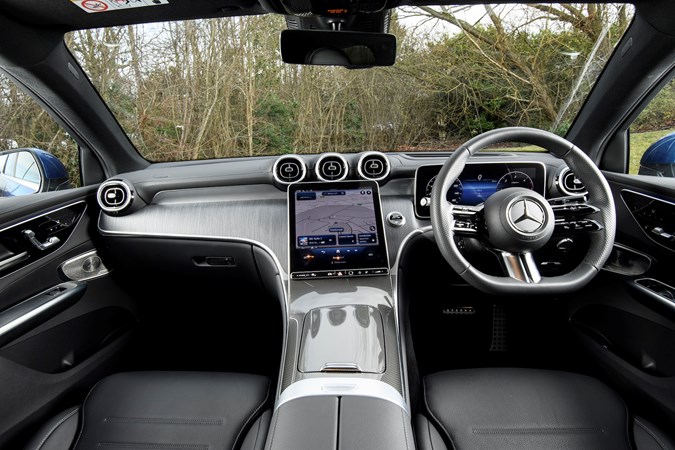
So, before we stepped behind the wheel of the Mercedes GLC Coupe, we formulated two questions to help us determine its worth. First, is its driving experience sporty enough to make keen drivers pick one over the standard GLC? And has its cabin been compromised so much by the rakish body to make it less attractive to those that value practicality?
If the answer to these questions are ‘yes’ and ‘no’ respectively, then Mercedes has done a good job with the GLC Coupe. If not, you’d be better off passing the coupe by and sticking with the standard SUV. Scroll down to learn how it stacks up against its rivals.
What’s it like inside?
Surprise, surprise – it’s like a GLC. The Coupe’s dashboard, infotainment system and seats have all been transferred wholesale from the conventionally shaped model, and it shares the same finish as its sister car. As such, we won’t go into too much detail about the car’s interior here. You can read more in our main review of the Mercedes GLC SUV.
However, we will mention that our car’s infotainment system cooked itself in the heat of a 30-degree Austrian summer. The result was painfully slow load times for the menus and a touchscreen that seared your fingerprints off when you tried to operate it. If global warming gets any worse, you can expect this problem to become a seasonal ritual.
Obviously, because it’s a coupe SUV, this version of the GLC has less space in the back than the standard car. Legroom is comparable between the two cars, but you lose an inch or so of headroom to the sloping rear end. Still, even six-footers can fit under the roof without craning their necks.
Boot space is also reduced from 620 litres in the standard SUV to 545 litres in the Coupe. That’s not a huge loss (indeed, it’s only five litres less than you get in the rear of the conventionally shaped BMW X3), but if you regularly need to carry both toddler detritus and luggage, stick with the standard car.
The biggest compromise you’ll make is visibility. The rear screen is incredibly small, quite narrow and very steeply raked, which means it’s basically useless. We found ourselves ignoring the rear-view mirror completely and relying on the door mirrors, as you would when driving a van.
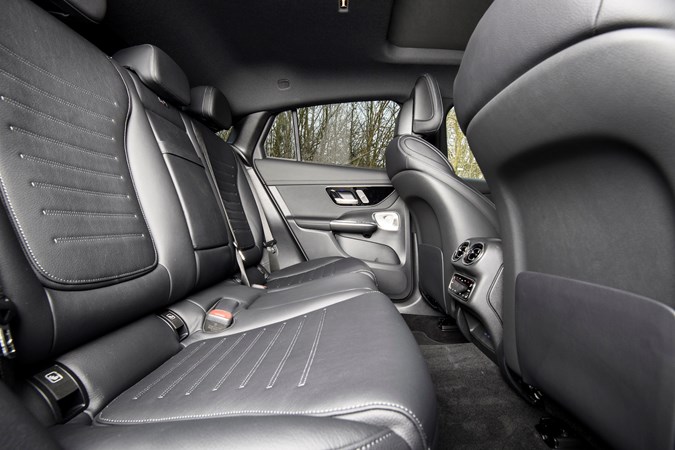
Safety
Euro NCAP hasn’t yet crash-tested the Mercedes GLC Coupe, but the car’s conventionally shaped sibling achieved a glowing five-star rating when it was put through its paces in 2022. Because both cars are mechanically and technologically identical, the Coupe should perform as well in a crash.
Standard safety equipment includes active lane-keeping assist, autonomous emergency braking, a tyre pressure monitoring system, two Isofix points for the rear seats and an active bonnet that will pop up on its hinges in the event of an impact with a pedestrian. Upgrades for AMG Line Premium cars and up include blind spot assist, traffic sign recognition and a 360-degree parking camera.
What’s it like to drive?
No prizes for guess this one correctly, either. It’s the same as the GLC SUV, which is to say rather heavy and not particularly engaging. It’s also worth noting that our driving impressions have been tainted by Mercedes’s choice of test cars. At our launch event, we were only given the chance to drive cars fitted with adaptive dampers and rear-wheel steering – neither of which are available in the UK.
Mercedes’s adaptive dampers make a negligible difference to the way the GLC handles. The change in chassis stiffness between the car’s comfort and sport drive modes is barely noticeable – and even with the adaptive dampers in their softest setting, we found the ride to be a little too firm.
The ride quality is worsened by specifying the largest 20-inch alloy wheels. The setup makes the car jiggly at low speeds, while amplifying road imperfections and transmitting them into the cabin. However, both ride comfort and refinement improve once you’re up to motorway speeds.
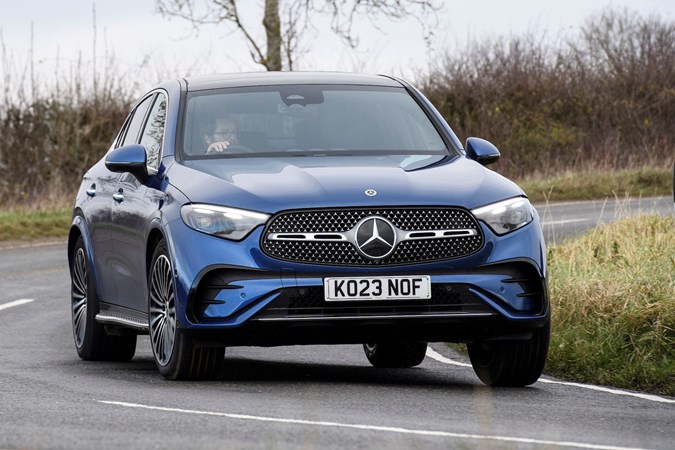
But while Mercedes’s adaptive dampers do little to improve the GLC Coupe’s driving experience, its rear-wheel steering system has a profound effect on the car’s agility. At low speeds, the rear wheels steer in the opposite direction to the front wheels, which makes the car feel smaller than it is and improves its ability to nose into a corner. This was a huge boon when threading together a series of hairpin bends on our challenging Alpine test route. It’s a shame we won’t get the tech in the UK.
We also get a reduced range of engines. European buyers can choose from four mild hybrid powertrains (two petrol, two diesel) and three plug-in hybrids (two petrol, one diesel). For whatever reason, though, Mercedes decided to slim down the GLC Coupe’s line-up for the UK market, ditching all three PHEV options and the least powerful petrol variant.
That leaves us with the 220d, 300d and the 300 petrol. The two diesel options are both based on the same 2.0-litre four-cylinder unit. The 220d produces 197hp and 440Nm of torque, while the 300d develops 269hp and 550Nm of torque. The 300 petrol, meanwhile, extracts 258hp and 400Nm of torque from its 2.0-litre four-cylinder unit.
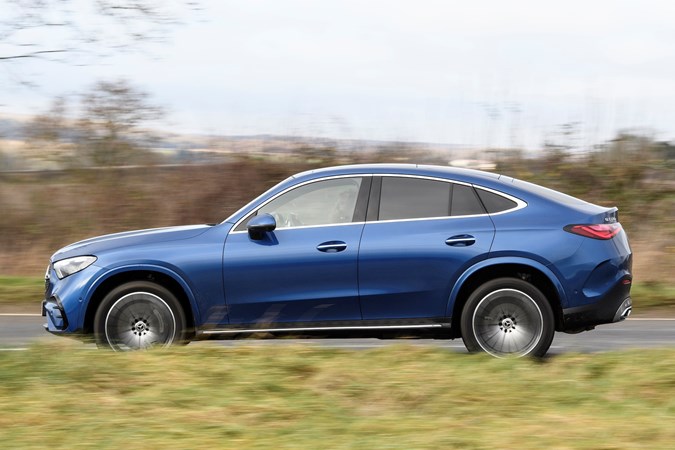
We’ve only experienced the two most powerful engines in the GLC Coupe so far, but we think the 300d is the engine to go for. The GLC Coupe is a heavy vehicle, weighing more than two tonnes – and that much heft makes even the most potent petrol engine feel rather breathless. But the 300d is genuinely fast, with enough pulling power to allow you to overtake confidently on the motorway or haul your entire family and all their luggage up an Alp.
It’s a little grumbly at low speeds, but it sounds pleasingly sporty when you accelerate hard. It isn’t even desperately unrefined, either. Once you’re up to speed and at the top of the car’s nine-speed automatic gearbox, the engine note dissipates into a background hum.
The gearbox can’t match the merits of the engine, though. It simply doesn’t react quickly enough when left to its own devices. Say you’re on a winding road, looking for an opportunity to overtake a dawdling tractor. Once you’ve found your gap and floored the throttle, it takes the gearbox a solid two seconds to shuffle through its deck of cogs before it allows you to accelerate, by which point you’re at the next corner and your window of opportunity has closed.
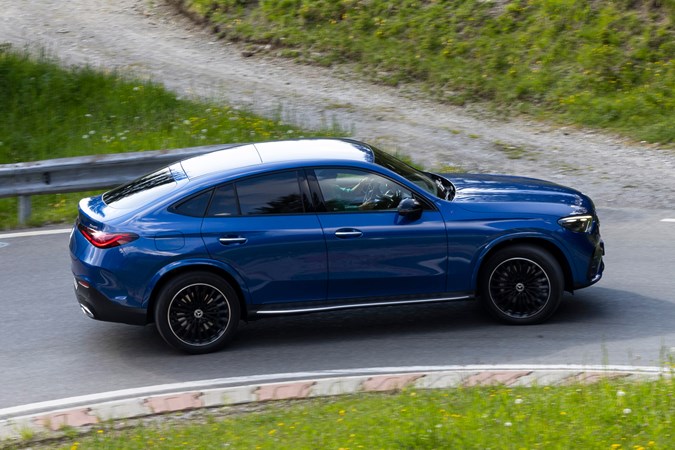
There also isn’t a way to lock the gearbox in manual mode an override the computer. You can temporarily take control of the gears with the paddles behind the wheel – but if you don’t interact with them for a while (such as when using engine braking to decelerate down a steep hill), it’ll switch back to automatic mode.
It’s also very clunky at low speeds. It’ll slam between first and second gear when dawdling around town with such ferocity, you’ll think you’ve stoved the sump into one of those retractable bollards. It certainly can’t live up to Mercedes’s sporting aspirations – the eight-speed gearbox fitted to the BMW X4 is far superior.
What models and trims are available?
Fewer than there should be. We’ve already mentioned that the GLC Coupe isn’t available with a plug-in hybrid powertrain, but UK buyers also can’t have the car’s cheapest Avantgarde specification. This is the case with every new Mercedes sold in the UK – sales of the firm’s AMG Line trim are strong enough in Britain for the brand to not bother shipping the cheapest model over the Channel.
However, in the case of the GLC Coupe, we feel there’s a case for the Avantgarde specification in the UK. It has smaller 18-inch alloy wheels, which would help improve the ride quality. And, given how much more expensive the Coupe is over the standard GLC, we’d have like to see a more affordable option for those that care more about the coupe looks than the fancy technology.
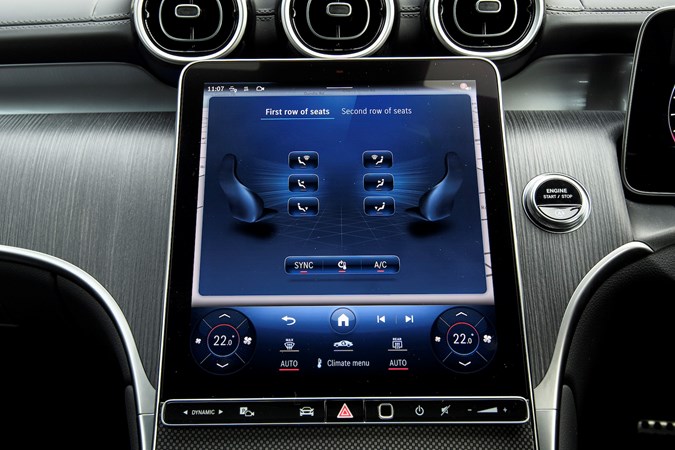
UK buyers can choose from Mercedes’s AMG Line, AMG Line Premium or AMG Line Premium Plus specifications. AMG Line cars come as standard with 19-inch alloy wheels, LED headlights, privacy glass, a sporty AMG body kit, black leather sports seats, a 12.2-inch digital gauge cluster and an 11.9-inch touchscreen.
AMG Line Premium upgrades over the cheaper model include 20-inch alloys, auto-dipping LED headlights, accoustic glass, keyless go and Mercedes’s ‘transparent bonnet’ system which can project an image of the underside of the front axle onto the infotainment system. The flagship GLC Coupe Premium Plus car gets a different set of 20-inch alloys, a panoramic sunroof and a Burmester stereo system.
Is it a niche too far? We genuinely don’t think so, especially considering how much effort Mercedes-Benz has put into making this one feel special. To find out how we rate it, read on for our verdict.



